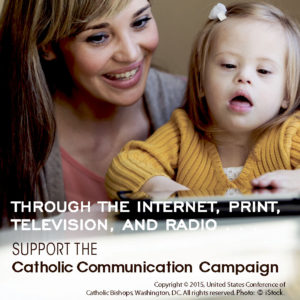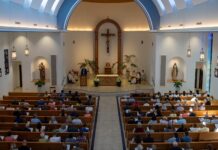May 7-8 second collection gives hope to elderly, homebound
We are called to communicate with mercy, Pope Francis said in his message for the 50th World Communications Day earlier this year.
“In a broken, fragmented and polarized world, to communicate with mercy means to help create a healthy, free and fraternal closeness between the children of God and all our brothers and sisters in the one human family,” the Holy Father said.
Heeding the words of Pope Francis, the U.S. Conference of Catholic Bishops will hold its annual Catholic Communication Campaign the weekend of May 7-8. Half the funds raised during the second collection at Masses that weekend support local diocesan communications needs. The remainder supports national communications initiatives, such as the USCCB website and Catholic News Service, and ministry projects such as podcasts of daily Scripture readings, the “Catholic Church App” and “myUSCCB” app and the “For Your Marriage” website. The funds were used to facilitate communications needs for the pope’s apostolic visit to the United States last year.
 “Without help from the Catholic Communication Campaign, the coverage of Pope Francis’ visit to the United States would not have been possible,” said Bishop Joseph J. Tyson of Yakima, Washington, chairman of the Committee on Communications’ Subcommittee on the Catholic Communication Campaign. “Through your generosity, the Gospel message has been lifted up in the media and conversations of people across the country and world.”
“Without help from the Catholic Communication Campaign, the coverage of Pope Francis’ visit to the United States would not have been possible,” said Bishop Joseph J. Tyson of Yakima, Washington, chairman of the Committee on Communications’ Subcommittee on the Catholic Communication Campaign. “Through your generosity, the Gospel message has been lifted up in the media and conversations of people across the country and world.”
In the Diocese of Phoenix, those funds are used to support the weekly televised Mass in English and Spanish, which provides a vital connection for elderly and homebound Catholics unable to get to Church. Every Sunday, the Holy Mass airs live on AZ-TV 7 / Cable 13 at 9 a.m. from Ss. Simon and Jude Cathedral. A Spanish-language Mass airs on Azteca America 41 at 10:30 a.m.
Both are followed by a short newsmagazine-style show, “Catholics Matter” hosted by Fr. Rob Clements in English and “Cultura y Fe” hosted by Cristofer Pereyra in Spanish.
“The Catholic Communication Campaign is vital to our mission of broadcasting the Holy Mass on television and YouTube each Sunday,” Rob DeFrancesco, diocesan director of communications, said. “Thousands of Catholics who are sick or homebound are not able to be physically present at Mass. The Catholic Communication Campaign makes it possible for us to bring the Eucharist to the faithful.”
EN ESPAÑOL: Campaña de comunicación, 7-8 de mayo, da esperanza a los ancianos, los que no pueden salir de casa
Joe Reynolds, the owner of Skyline Productions — which produces the Mass in English, said he views what he does “as an opportunity to evangelize to people I’ll never know. We take it very seriously every week.”
In addition to being aired on television, both Masses are also streamed on YouTube and broadcast on the radio.
Reynolds, a parishioner at St. Timothy in Mesa, shared how one man stumbled upon the Mass on YouTube while visiting China, where he was unable to find a Mass to attend, or how a group of Catholics in Egypt is using the Mass as a catechetical tool.
“We’re taking technology and using it for good, and using it to get the message of Christ out there using these tools we have available to us,” he said.
Approximately 60,000 to 70,000 people tune in to the Mass in 1,500 cities across the United States and in 105 countries worldwide, Reynolds said. This year also marked the first time that the Holy Thursday liturgy aired on TV in the diocese.
Fr. Daniel McBride, pastor of St. Mary Parish in Chandler and producer for the Spanish Mass, said making the Mass accessible to those who aren’t able to attend is an act of mercy.
“Someone who can’t possibly go to Mass on Sunday, and they watch the Mass in Spanish — people in prisons, nursing homes, people who can’t get to Mass,” said Fr. McBride, “that’s the work of mercy.”
Fr. McBride joked that it can be difficult to produce the Mass while he’s celebrating it because “I can’t tell the people which camera to switch to.”
While the Spanish Mass has only been on TV for two years, it has been on YouTube for four. Fr. McBride said people from 150 countries watch the Spanish Mass online on a regular basis, and that 25 to 30 percent of the viewers are from Mexico.
He recalled how Dcn. Manuel Olivas, who regularly assists at the Mass, visited a border town in Mexico and somebody approached him and asked if he was deacon from the Mass he watched every Sunday.
“You don’t know where the reach goes,” Fr. McBride said. “It’s like a throwing a seed on the ground, you don’t know who’s going to be reached.”







